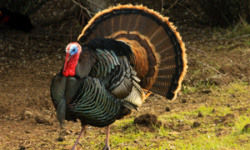When you are out turkey hunting, before you take the shot - look for the beard to be sure!
There are several reasons why turkey hunting is one of the more accident-prone of the field sports: Everyone out there is camouflaged from head to toe; we’re all making sounds like the birds we’re hunting; and we all know a gobbler’s head is red, white, and blue.
Those same reasons should make turkey hunters extra cautious, but not every hunter remembers all the safety rules when he’s dead certain that’s a gobbler over by that big oak.
There is one rule, however, that would virtually ensure an accident-free hunt, if every turkey hunter obeyed it: Don’t shoot until you see a beard!
In spring, any male or bearded turkey is a legal target, but some hunters don’t give enough thought to distinguishing a tom from a jake, hen, or non-target until it’s time to shoot. You’ll have a safer hunt if you brush up on basic turkey identification and keep the beard rule foremost in mind.
Tom, jake, or hen? A male turkey is larger than a hen, but the sexes can also be
differentiated by feather color, head color, leg spurs, and the presence of a beard.
The body feathers on males, regardless of their age, have black tips and a shiny, iridescent sheen. A hen’s body feathers have buff tips and a dull, dusky finish. From a distance, males look big, shiny, and black, while hens look smaller, drab, and brown.
Turkeys do not molt all their tail feathers in the first year of life. A juvenile bird’s central tail feathers are longer than its outer tail feathers. When a jake, or juvenile male, displays his fan, the central tail feathers stick up an inch or two above the rest of the fan.
A hen’s head is typically dull gray or blue in color. Males’ heads can appear bright blue, red, or white, depending on their level of excitement. In spring, a male’s head is generally bright red. When he’s in full strut, the top of his head turns white. When a strutting male walks toward you, his head looks like a softball against his fanned-out tail.
Adult males, or gobblers, also have fleshy wattles and caruncles on their head and neck and a snood on their beak. These fill with blood and turn bright red when the bird is excited, and the snood hangs down several inches below the beak.
Males have spurs on the backs of their legs that grow longer and more pointed each year. Spur length is a reliable method for aging toms. A jake, or yearling male, has spurs less than a half-inch long. A 2-year-old male has spurs one-half to 1-inch long. Toms older than age 3 have spurs at least an inch long. Toms kick at each other with their spurs when fighting.
Males also have beards, which consist of a group of coarse bristles growing out of the skin of their breast. Jakes usually have beards shorter than 5 inches. A 2-year-old tom’s beard is usually at least 8 or 9 inches long. Beard length is not a good indicator of age, as the tips of the bristles wear and break from contact with the ground or tree limbs.
From 1 to 5 percent of hens also have beards, but these are usually short and wispy. Bearded hens have all the other characteristics of normal hens. A bearded hen is a legal target, but most hunters pass them up in favor of a tom.
All turkeys cluck, yelp, and purr, but toms and jakes are the only turkeys that will gobble. A mature tom’s gobble lasts several seconds and has a lusty rattle. A jake’s gobble attempts are often hesitant and comical. Jakes may yelp-gobble or break off a gobble after two or three syllables. They sound like adolescent boys trying out a new voice, which is just what they’re doing.
Hunt safely
Keep a mental checklist of these sex characteristics, and you should have no trouble telling a hen from a tom or a jake. As a bird walks into range, ask yourself: black or brown body? Red or gray head?
When a turkey gets close enough to shoot, before you push off the safety, look for the beard. It’s a rare tom that has lost its beard to a fight or freezing weather. That extra second or two you take to identify your target with absolute certainty just might spell the difference between a successful hunt and a tragic mistake.






